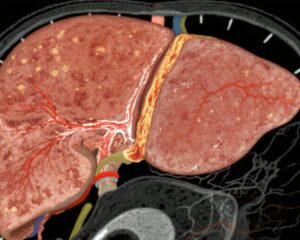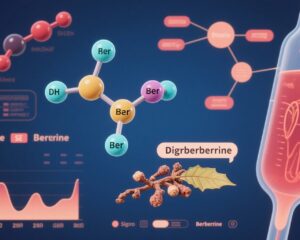Highlight
– HTD1801, a gut-liver anti-inflammatory metabolic modulator, significantly lowered HbA1c in patients with type 2 diabetes inadequately controlled by diet and exercise.
– Dose-dependent HbA1c reductions were accompanied by improvements in fasting plasma glucose, lipid profiles, and liver injury markers.
– The treatment was safe, well tolerated, and supports an oral therapeutic option addressing diabetes and its metabolic comorbidities.
Study Background and Disease Burden
Type 2 diabetes (T2D) is a chronic metabolic disorder characterized primarily by hyperglycemia due to insulin resistance and progressive beta-cell dysfunction. Despite numerous available therapies targeting blood glucose, few comprehensively target the underlying metabolic and inflammatory milieu that contribute to T2D progression and associated comorbidities such as nonalcoholic fatty liver disease (NAFLD), cardiovascular disease, and systemic inflammation. Effective management thus requires agents that can modulate glycemia alongside liver and cardiometabolic health.
Berberine, a plant-derived alkaloid, exhibits glucose-lowering and lipid-modulating effects but suffers from limited bioavailability. Ursodeoxycholate, a bile acid derivative, has hepatoprotective properties. Berberine ursodeoxycholate (HTD1801) is a novel combination acting as a gut-liver axis anti-inflammatory metabolic modulator designed to address core metabolic derangements in T2D beyond glycemia.
Study Design
This phase 2 double-blind, placebo-controlled, randomized clinical trial was conducted at multiple centers in China from March 2022 to January 2023.
The study enrolled 113 adult patients with T2D inadequately controlled after at least 8 weeks of diet and exercise (HbA1c 7.0% to 10.5%, fasting plasma glucose [FPG] <250.5 mg/dL). Patients were randomized 1:1:1 to receive either placebo (n=38), HTD1801 500 mg twice daily (n=37), or HTD1801 1000 mg twice daily (n=38) orally for 12 weeks.
The primary endpoint was the change in HbA1c from baseline to 12 weeks, analyzed by mixed-effects model for repeated measures. Secondary endpoints included fasting plasma glucose, lipid parameters, markers of liver injury, and safety assessments.
Key Findings
Baseline characteristics were balanced among groups: mean age 54.3 years, 63.7% male, mean baseline HbA1c 8.2%, body mass index 25.5 kg/m2, and mean FPG 160.7 mg/dL.
1. Glycemic Control:
– HTD1801 induced significant dose-dependent reductions in HbA1c at 12 weeks compared with placebo:
– 500 mg group: LS mean difference -0.4% (95% CI, -0.79% to -0.03%; P=0.04)
– 1000 mg group: LS mean difference -0.7% (95% CI, -1.10% to -0.35%; P<0.001)
– Corresponding mean reductions in fasting plasma glucose were observed: -13.0 mg/dL and -18.4 mg/dL in 500 mg and 1000 mg groups, respectively.
2. Lipid and Liver Parameters:
– The 1000 mg group showed reductions in total cholesterol and triglycerides.
– Liver injury markers (e.g., alanine aminotransferase) demonstrated improvements, suggesting hepatoprotective effects of HTD1801.
3. Safety and Tolerability:
– HTD1801 was well tolerated; 97.3% of participants completed the study.
– Adverse events were generally mild and occurred in 52.2% of patients overall.
– One serious adverse event (retinal hemorrhage) occurred in the 500 mg group but was unlikely related to treatment.
– No discontinuations due to adverse events were reported.
Expert Commentary
This investigation of HTD1801 represents a significant step toward therapeutics addressing the multifactorial nature of T2D. The combination targets gut-liver metabolic inflammation while delivering modest but clinically relevant glycemic improvements. The dose-dependent HbA1c and FPG reductions parallel benefits in lipid and liver injury markers, which may translate into improved long-term outcomes.
Limitations include the relatively short 12-week duration and single geographic region. The study population had moderately elevated HbA1c and normal to mildly elevated BMI, limiting extrapolation to more advanced or obese populations. Ongoing phase 3 trials will clarify the long-term efficacy, safety, and cardiovascular benefits.
Biologically, HTD1801’s dual action on gut metabolic signaling and hepatic inflammation may restore metabolic homeostasis, a mechanism distinct from classical glucose-lowering drugs. This offers a potentially complementary strategy alongside existing therapies.
Conclusion
In summary, berberine ursodeoxycholate (HTD1801) shows promise as an oral treatment for type 2 diabetes that goes beyond glycemic control by improving cardiometabolic and liver parameters. The favorable safety profile and significant metabolic benefits support further development in larger, longer-term trials. HTD1801 may emerge as an innovative therapeutic option addressing both hyperglycemia and the metabolic inflammation underlying T2D and its comorbidities.
References
Ji L, Ma J, Ma Y, Cheng Z, Gan S, Yuan G, Liu D, Li S, Liu Y, Xue X, Bai J, Wang K, Cai H, Li S, Liu K, Yu M, Liu L. Berberine Ursodeoxycholate for the Treatment of Type 2 Diabetes: A Randomized Clinical Trial. JAMA Netw Open. 2025 Mar 3;8(3):e2462185. doi: 10.1001/jamanetworkopen.2024.62185. PMID: 40029660; PMCID: PMC11877176.



